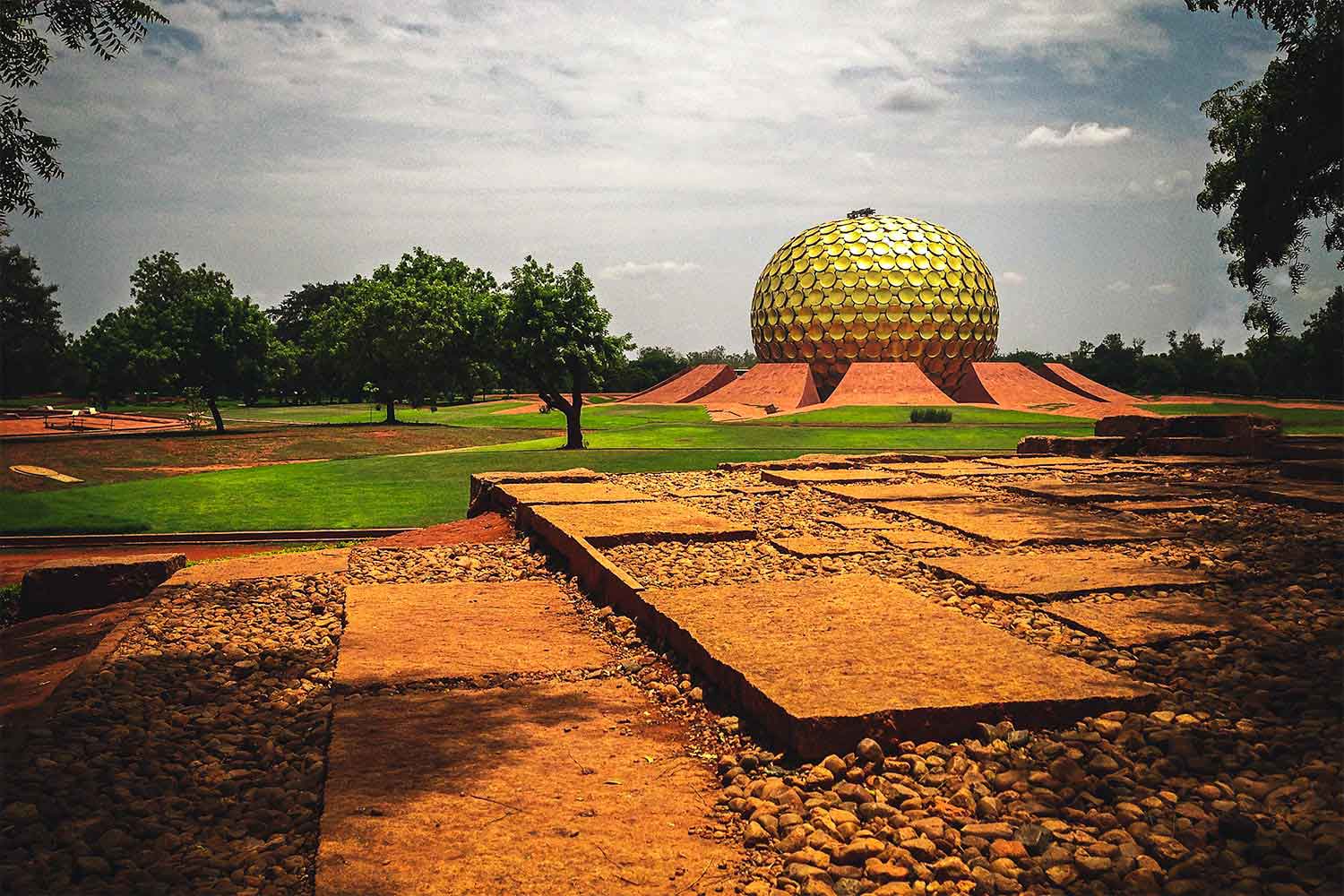A Short Trip to Auroville, and the Aurobindo Ashram
A weighty hush kept everybody in silence. My wife pinched my arm to show me things.

Aurobindo Ashram
It was a Saturday morning and crowded. A busload of schoolgirls just had been cleared ahead of us. The staff were efficient in regulating visitors. In a couple of minutes, we'd taken off our shoes and gone in, unshod on hallowed ground, guided by smiles and quiet words. We arrived into complete silence in an open-to-air setting. A line of volunteers kept us in check, walling up the short distance to the samadhis of Aurobindo, and the Divine Mother — a marble block of rectangular section. At the samadhi, the line broke, and we were free to kneel and feel the marble. Many rested their brow on the marble block in obeisance to the Hindu philosopher and his Spiritual Partner. They're are both interred beneath the single stone. Afterwards, we squatted in the shade in a verandah close by. A weighty hush kept everybody in silence. My wife pinched my arm to point to things.
So much solace people drew from that stone in the heat of Pondicherry. Most visitors were Indians. I noticed a white man who'd been squatting in the yard. He got up to leave just as we sat, and went up to the samadhi to say goodbye before he left. He was wearing a veshti, clean and white and better gathered at the waist than any veshti-clad Indian's. On top, he wore a saffron T-shirt. He caught my attention because he had the demeanour of the satvik, a sādhvi, full of gravitas, and oblivious to the world around. As I watched, he knelt, closed his eyes, and pressed his brow to the marble.
Another face. Pretty, its beauty multiplied by the bliss on it. All others had their eyes on the samadhi, so I watched this face freely. She went around the stone and knelt with her back toward me and rested her cheek on the marble. And sank into oblivion. Even when we were leaving, she was there, arms on the stone, stone and cheek pressed together, eyes shut. Right Thinking washed over me as I stepped out, shaming me for having stared. I went into the bookshop and stood before pictures of Aurobindo and the Mother. I rather envied Aurobindo his eyes, his height, his Christlike beard.
Auroville
There's the Aurobindo Ashram, which I've been describing until now, which is in the French Quarter of Pondicherry, and there's the sprawling Auroville, 12-kilometers north of Pondicherry, founded by French-born Mirra Alfassa, anointed Divine Mother by Aurobindo himself. Begun well after Aurobindo's death, Auroville was Mother's plan was to manifest in Auroville Aurobindo's vision in its totality. Arid at the time of founding, Auroville is now "a land of milk and honey", and neem and tamarind, and well-watered green grass flourishing in the sweltering heat. And it is a source of leather goods and ethnic clothing and incense and aromatic oils and semiprecious ornaments and a hundred kinds of trinkets for men and women.
When the Mother founded Auroville, the vision was to draw 50,000 "servitors" fit for the quest for what Aurobindo called the Life Divine. Only a little more than 2000 have been mustered for the cause in the forty years that have passed — half of them Indian, the rest mostly French and German. The founding was a grand affair, with representatives from each independent nation gathered on bare undeveloped ground that would become Auroville. To the rites that were performed, the UNESCO added its blessings. The delegates had brought with them soil from their homeland, to pour it in an urn on this campus which would "spearhead the evolutionary process of man." So that "all humankind would eventually experience the Life Divine right here on earth," through engaging in the Integral Yoga championed by Aurobindo.
How the "Aurovilians" live is hard to tell for the first time visitor on a day-trip. The closest a first-visit can get one to in Auroville is a distant viewing of the Matri Mandir, a "hall of contemplation." A white hall it is said to be, a hall of silence, set in a giant golden globe which, seen from the outside looks like a huge golf ball. But, of course, its beauty is more contained in its details, drawn in the main from Hindu iconography — and the meanings the Mother attached to every little thing.
To view the globe you first watch the 10-minute video at the Visitor Centre, which deconstructs the sphere and shows how its form, content and design are consistent with Aurobindo's vision. It is all very moving, and puts you in the mood for the long walk in the sun to the viewing point, which is a clump of trees with shingle around their trunks and stone-slabs and a low hedge that none dare cross. Rules work when they're backed by divinity.
To go into the Matri Mandir, you should apply a day in advance. It is all very Western, a system to achieve Oriental divinity in the manner of the West has mastered. Which means this exclusive expanse of land which is home to two-thousand favoured people lives a tenuous existence with the not-so-attractive villages round it. But travellers have known for centuries the means which to gain favour with local Indians. Not too far from the Visitors Centre, the claim is made on a plaque that people on this arid land have been waiting for foreigners to come and "save them." Having come now, the plaque says, a 500-year-old prophecy is fulfilled.
The Prophecy From the Legend of Irumbai.
Abutting the Auroville campus lies the Irumbai village. Five-hundred years ago, a yogi, Kaduveli Siddha, sat there and did a penance so harsh, his heat turned the place Auroville now occupies into an inferno. By the guiles of Vellai, the dancing girl of the village temple, the effects of his penance were neutralized with no damage done to his spiritual vows. Pleased that the crisis was over, the king of the realm ordered a thanksgiving at the Irumbai temple, featuring a dance by Vellai herself.
But the story doesn't end here.
Vellai danced so well the yogi saw Shiva in her, and when she did a complicated movement, and her anklet came loose, the yogi leaned forward and tied it back. The king and the courtiers mocked the yogi for ministering to a dancing girl. Outraged, the yogi invoked Shiva, who, intervening, caused the lingam in the temple to explode, and everywhere the pieces of that symbol of Shiva's phallus fell, the land became infernal all over again. The king collapsed in a heap at the yogi's feet.
"What is done can't be undone," the yogi said. "But your contrition is true. One day people will come from far off places and save your land."
Foreigners came a good five-hundred years after the king and the yogi went into their graves. They have indeed developed the land, cultivated it, built buildings on it. You can buy the things that come off the foreigners' works at the air-conditioned Auroville boutique in Pondicherry. The quality of their produce is all right, and the service isn't bad. I bought a leather portfolio there, and a Brahmi tonic to boost my memory. My wife bought Yoga shampoo, incense, oils, and after thinking a moment, a pearl necklace.
The question is: Who, or which, came first? The foreigners? Or the story of Irumbai? I'll rest the matter here.
